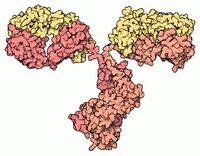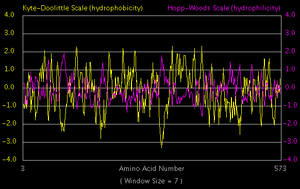Generating antibodies

You are hot in pursuit of an interesting protein but there are no commercial antibodies or they are bad. It's time to think about raising your own antibodies against the protein. It will be a time and money consuming undertaking but once you developed a specific antibody or set of antibodies, you will be in a unique position to generate interesting data.
Early decisions
Type of antibody
polyclonal (a mix of antibodies with different specificities)
|
monoclonal (many copies of the same antibody)
|
Source organism
Common animals for raising antibodies include rabbit, goat, mouse (required for monoclonal antibodies), and even llamas [1]. The choice depends on which antibodies will be used in conjunction with antibody to be generated and which type of antibody is desired.
Type of antigen to use
full-length protein
|
peptide
|
Peptide selection

If you decide to raise antibodies against a peptide or several peptides from the target protein, you will be faced with the question which region to choose. The gist is, you want to pick a 15-20 residue peptide that is on the surface of the protein, i.e. has a high hydrophilicity. Another common approach is to pick sequences from the ends of the protein, since they are typically exposed. Avoid cysteines if possible, since peptides will often be coupled via Cys residues to carriers and since disulphide bridges alter the shape and thus the recognition by antibodies. Still, peptide selection is trial and error.
Online tools
- Instructions for peptide prediction (EMBL)
- Background of peptide prediction (Antigenic tool, Harvard)
- Useful information about peptide design (Pierce)
Sequence plots
- ExPASy's classic ProtScale tool allows you to check a protein sequence against various amino acid scales including several for hydrophilicity/-phobicity
- pepwindow hydrophobicity tool from the Institute Pasteur (default Kyte-Doolittle)
- Hydrophobicity tool by Colorado State Uni - well documented but x scale not sufficiently subdivided
Peptide prediction
Tools attempting prediction of immunogenic peptides given the protein sequence. Both are based on Kolaskar and Tongaonkar "A semi-empirical method for prediction of antigenic determinants on protein antigens." FEBS Letters 1990 (PMID 1702393). The estimated accuracy of prediction is 3 in 4 peptides or 75%.
- Harvard Antigenic tool (fast but no scoring of peptides)
- EMBOSS antigenic tool (slow, peptides ordered by score)
- AbDesigner (Prediction software using hydropathy, includes Blast and gives a good overview, data is exportable)
Other
- Peptide design check by Innovagen (no explanation of reasoning)
- Protein Colourer tool from the EBI may be helpful to inspect the sequence by eye
Further reading
- Rapberger 2007 "Identification of discontinuous antigenic determinants on proteins based on shape complementarities." PMID 17421048
- Söllner 2006 "Machine learning approaches for prediction of linear B-cell epitopes on proteins." PMID 16598694
- Batori 2006 "An in silico method using an epitope motif database for predicting the location of antigenic determinants on proteins in a structural context." PMID 16193533
- Kulkarni-Kale 2005 "CEP: a conformational epitope prediction server." PMID 15980448, http://bioinfo.ernet.in/cep.htm
Boosting the immune reaction

A small peptide is often not enough to elicit sufficient antibody production. Several methods, also in combination, can be used to stimulated the immune system.
- Multimers of the peptide often increase antibody synthesis. Multimers can be made by linking several copies of the peptide as branches to a carrier peptide chain.
- Adjuvants are mixtures co-injected with the antigen to stimulate the immune response. Complete Freund's adjuvant (CFA), typically made from inactivated mycobacteria, is a common choice. However, newer adjuvants like Ribi's adjuvent and Titermax are safer for both scientist and animal. [2] See also adjuvant in the wikipedia.
Pitfalls
- antigen is a poor immunogen; consider coupling to a carrier if not already done; consider polymersiation of antigen with glutaraldehyde; choose a different peptide
- too little antigen was used; this will be an issue if your antigen is hard to produce and therefore scarce
- protein or peptide preparation is not pure; contaminant is more immunogenic than desired epitope; resulting antibody does not recognised the right target
- adjuvant might not be suitable; try a different one and a different antigen/adjuvant ratio
- oil-in-water emulsion might not be good enough (a drop of a good emulsion will float on cold water)
- if using outbred animals, individual variation of immune reaction will be significant; make sure a large enough group is immunised
See also
External links
 Guidelines for polyclonal antibody production by Animal Care and Use Committee, UC Berkeley - full of up-to-date, technical advice viewed from animal health point of view
Guidelines for polyclonal antibody production by Animal Care and Use Committee, UC Berkeley - full of up-to-date, technical advice viewed from animal health point of view Antibody production tips from AnaSpec, Inc. (detailed information on several pages, little advertisement)
Antibody production tips from AnaSpec, Inc. (detailed information on several pages, little advertisement) FAQ on antibody generation by Alta Bioscience Ltd, UK (useful technical tips and a little advertisement)
FAQ on antibody generation by Alta Bioscience Ltd, UK (useful technical tips and a little advertisement) Backgrounder on history, generation, and application of monoclonal antibodies by Mark Soloski, Johns Hopkins
Backgrounder on history, generation, and application of monoclonal antibodies by Mark Soloski, Johns Hopkins- Hybridoma and in vitro generation of antibodies, Antibody Facility, UNC Chapel Hill
- Monoclonal Antibodies: A Practical Approach by Philip Shepherd, Christopher Dean on Google Book Search
- Protocol for raising polyclonal antibodies in rabbits, Chew lab, Uni of Singapore
Protocol Online (methods forum)
- Protocol-online.org archive, keyword antibody and discussions indexed under antibody
- Discussion on affinity purification
- Discussion on antigen amount
Wikipedia